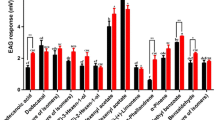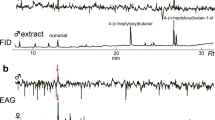Abstract
Aggregation of Rhynchophorus palmarum weevils on host plants is mediated by a male pheromone (rhynchophorol: R) and host-plant volatiles (PVs) acting in synergy. Synthetic PV blends synergizing pheromone contain acetoin (A) and ethyl acetate (EtAc). R, A, and EtAc are detected by specialized olfactory receptor neurons (ORNs). In addition, particular types of ORNs are tuned to both A and R. To specify the role played by acetoin in pheromone perception, we recorded the responses of ORNs to 100 ng of A or R presented either separately or mixed. Behavioral responses to R, A, and EtAc were studied in a four-armed olfactometer and by field trapping. We screened 59 R-, A-, and AR-tuned ORNs by recording specific responses to odors presented either separately or mixed. Stimulations by blends elicited complex response profiles from the three ORN types: some gave synergistic responses, others were inhibited, and the remainder responded as though both odors were detected independently. Several gave either a weak or no response to a first stimulation by R, but responded clearly to a second stimulation after an intercalary stimulation by A. In the olfactometer, both sexes were more attracted to a blend of A + R (1 + 0.01 ng/sec) than to pure compounds, whereas EtAc did not enhance response to R. Pheromone-baited traps (1 mg/day) containing PV blends (650 mg/day) based on an ethanol/EtAc blend (1:1), plus either 5 or 10% A, or a more complex reference blend, or sugarcane (natural pheromone synergist), caught similar numbers of weevils and about twice as many insects as a control ethanol/EtAc blend. Traps with only pheromone caught about 10 times fewer insects. Behavioral results support the role of acetoin as a pheromone synergist for R. palmarum, and electrophysiological data provide evidence of modulation of peripheral sensory responses to pheromone by acetoin. Sexual dimorphism was observed neither at the ORN nor at the behavioral levels.







Similar content being viewed by others
References
B. W. Ache R. A. Gleeson H. A. Thompson (1988) ArticleTitleMechanisms for mixture suppression in olfactory receptors of the spiny lobster Chem. Senses 13 425–434
R. J. Bartelt B. W. Zilkowski (1998) ArticleTitleA versatile and quantitative volatile-delivery system for laboratory bioassays J. Chem. Ecol. 48 183–187
M. A. Carlsson B. S. Hansson (2002) ArticleTitleResponses in highly selective sensory neurons toblends of pheromone components in the moth Agrotis segetum J. Insect Physiol. 48 443–451
S. I. Cromarty C. D. Derby (1997) ArticleTitleMultiple excitatory receptor types on individual olfactory neurons: implications for coding mixtures in the spiny lobster J. Comp. Physiol., A 180 481–491
S. I. Cromarty C. D. Derby (1998) ArticleTitleInhibitory receptor binding events among the components of complex mixtures contribute to mixture suppression in responses of olfactory receptor neurons of spiny lobsters J. Comp. Physiol., A 183 699–707
P. Dagnelie (1975) Théorie et Méthodes Statistiques, Applications Agronomiques, vol. 2 Les Presses Agronomiques de Gembloux Belgium
R. Jong ParticleDe J. H. Visser (1988) ArticleTitleSpecificity-related suppression of responses to binary mixtures in olfactory receptors of the Colorado potato beetle Brain Res. 447 18–24
C. Derby M. Huston A. Livermore W. H. Lynn (1996) ArticleTitleGeneralisation among related complex odorant mixtures and their components, analyses of olfactory perception in the spiny lobster Physiol. Behav. 60 87–95
Ferreira, J. M. S., Araujo, R. P. C., and Sarro, F. B. 2001. Armadilha pet para captura de insectos adultos da broca-do-olho-do-coqueiro, Rhynchophorus palmarum. Circular tecnica no. 22. Embrapa, Tabuleiros Costeiros, Aracaju, Brazil. ISSN1517-1329. 15 p.
W. M. Getz R. P. Akers (1997) ArticleTitleResponses of American cockroach (Periplaneta americana) olfactory receptors to selected alcohol odorants and their binary combinations J. Comp. Physiol., A 180 701–709
B. S. Hansson J. N. C. Pers ParticleVan Der J. Löfqvist (1989) ArticleTitleComparison of male and female olfactory cell response to pheromone compounds and plant volatiles in the turnip moth, Agrotis segetum Physiol. Entomol. 14 147–155
B. S. Hansson M. C. Larsson W. S. Leal (1999) ArticleTitleGreen leaf volatile-detecting olfactory receptor neurons display very high sensitivity and specificity in a scarab beetle Physiol. Entomol. 24 121–126
P. J. Landolt T. W. Phillips (1997) ArticleTitleHost plant influences on sex pheromone behavior of phytophagous insects Annu. Rev. Entomol. 42 371–391
F. Marion-Poll (1995) ArticleTitleObject-oriented approach to fast display of electrophysiological data under MS-Windows J. Neurosci. Methods 63 197–204
F. Marion-Poll (1996) ArticleTitleDisplay and analysis of electrophysiological data under MS-Windows Entomol. Exp. Appl. 80 116–119
Morin, J.-P. and Ollivier, L. 2001. New Technology of Pest Management against Insect Pests of Oil Palm and Coconut Crops: Research on and Development of Selective Trapping using Synthetic Attractants, INCO contract ERB 18 CT 970 199: Year 4—Annual Report No. 4, Nov. 2001. Doc CP-SIC no. 1419. CIRAD, Montpellier France. 215 p.
H. Mustaparta (1984) Olfaction W. J. Belland R. T. Cardé (Eds) Chemical Ecology of Insects Chapman and Hall Ltd. USA 37–70
S. A. Ochieng K. C. Park T. C. Baker (2002) ArticleTitleHost plant volatiles synergise responses of sex pheromone-specific olfactory receptor neurons in male Helicoverpa zea J. Comp. Physiol., A 188 325–333
A. C. Oehlschlager C. M. Chinchilla L. M. Gonzalez R. Jiron L. F. Mexzon B. Morgan (1993) ArticleTitleDevelopment of a pheromone based trapping system for Rhynchophorus palmarum (Coleoptera: Curculionidae) J. Econ. Entomol. 86 1382–1392
D. Rochat C. Malosse M. Lettere P.-H. Ducrot P. Zagatti M. Renou C. Descoins (1991) ArticleTitleMale-produced aggregation pheromone of the American palm weevil, Rhynchophorus palmarum (L.) (Coleoptera: Curculionidae), collection, identification, electrophysiological activity and laboratory bioassay J. Chem. Ecol. 17 1221–1230
D. Rochat P. Nagnan-Le Meillour J. R. Esteban-Duran C. Malosse B. Perthuis J.-P. Morin C. Descoins (2000) ArticleTitleIdentification of pheromone synergists in American palm weevil, Rhynchophorus palmarum, and attraction of related Dynamis borassi (Coleoptera, Curculionidae) J. Chem. Ecol. 26 155–187
D. Rochat J.-P. Morin T. Kakul L. Beaudoin-Ollivier R. Prior M. Renou I. Malosse T. Stathers S. Embupa S. Laup (2002) ArticleTitleActivity of male pheromone of the Melanesian Rhinoceros beetle Scapanes australis J. Chem. Ecol. 28 479–500
D. Rochat K. Mohammadpoor C. Malosse A. Avand-Faghih M. Lettere J. Beauhaire J.-P. Morin A. Pézier M. Renou G. A. Abdollahi (2004) ArticleTitleMale aggregation pheromone of date palm fruit stalk borer Oryctes elegans J. Chem. Ecol. 30 387–407
Saïd, I. 2003. Etude de la réponse synergique au signal ‘phéromone–kairomone’ chez le charançon du palmier: Rhynchophorus palmarum (L.) (Coleoptera, Curculionidae): Approches olfactométrique et électrophysiologique. PhD thesis. Ecole Nationale Supérieure Agronomique de Rennes, France. 119 p.
I. Saïd D. Tauban M. Renou K. Mori D. Rochat (2003) ArticleTitleStructure and function of the antennal sensilla of the palm weevil Rhynchophorus palmarum (Coleoptera, Curculionidae) J. Insect Physiol. 49 857–872
L. L. Stelinski R. James J. R. Miller E. Noah N. E. Ressa L. J. Gut (2003) ArticleTitleIncreased EAG responses of tortricid moths after prolonged exposure to plant volatiles: evidence for octopamine-mediated sensitization J. Insect Physiol. 49 845–856
T. Tolasch S. R. Solter M. Toth J. Ruther W. Francke (2003) ArticleTitle(R)-Acetoin female sex pheromone of the summer chafer Amphimallon solstitiale (L.) J. Chem. Ecol. 29 1045–1050
Acknowledgments
We are grateful to two anonymous reviewers for useful comments and Ann Porter Cloarec for the English revision. This research was supported by the European Union funding (INCO project ERB-IC-18CT970199).
Author information
Authors and Affiliations
Corresponding author
Rights and permissions
About this article
Cite this article
Saïd, I., Renou, M., Morin, JP. et al. Interactions between Acetoin, a Plant Volatile, and Pheromone In Rhynchophorus palmarum: Behavioral and Olfactory Neuron Responses. J Chem Ecol 31, 1789–1805 (2005). https://doi.org/10.1007/s10886-005-5927-4
Received:
Revised:
Accepted:
Published:
Issue Date:
DOI: https://doi.org/10.1007/s10886-005-5927-4




